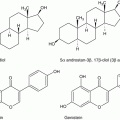Menorrhagia
Endometriosis
Metrorrhagia
Ovarian cysts
Hypermenorrhea
Benign breast diseases
Myomas
Endometrial carcinoma
Adenomyosis
Ovarian carcinoma
Endometrial hyperplasia
In such a hormonal milieu, typical menopausal symptoms and signs occur: hot flushes, insomnia and sleep disturbances, depression, loss of concentration, irritability, mood swings, gaining weight, painful bones, blood pressure variations, headaches, dry skin, vaginal dryness, and loss of libido inducing sharp decline in the quality of life. All those symptoms and signs vary from women to women. Some women have unremarkable changes, while others have terrible changes inducing unacceptable way of living. The World Health Organization requires from all doctors in the world to offer adequate therapy for women passing from reproductive period to the menopause without symptoms.
18.4 Contraception
Is contraception necessary in the climacterium? In the United States, 38 % of unplanned pregnancies happened in women over 40 years of age, representing similar percentage with that in young women [2]. The live births of mother aged 40 and over doubled from 13 555 (1998) to 26,419 (2008) in the United Kingdom. The latest data confirmed that sterility cannot be assumed until at least at the age of 60 years. So, although a natural decline of fertility occurs from mid-30s, effective contraception is required to prevent an unwanted pregnancy. The age is not a contraindication to any method of contraception.
Contraceptive choice may be influenced by frequency of intercourse, sexual problems, medical conditions, menstrual dysfunctions and wish for noncontraceptive benefits [3]. Depending on wish for having more babies, contraceptive methods can be reversible and permanent (Table 18.2).
Table 18.2
Reversible and permanent contraception
Reversible contraception |
1. Birth control pills |
2. Rings and patches |
3. Progestogens: Depo Provera, Mirena |
4. Nonhormonal options |
Permanent contraception |
Sterilization: |
A. Tubal ligation – block the tubes with the ring |
B. Nonsurgical procedures – small devices are inserted in the fallopian tube where over 3 months, it forms a tissue barrier |
1.




Birth control pills
Birth control pills prevent pregnancies, control menstrual period, lighten menstrual bleeding, relieve menstrual pain, treat premenstrual syndrome, treat polycystic ovary diseases, and prevent ovarian and endometrial carcinomas.
Combined oral contraceptive pills (COCP) are advised to healthy, normotensive nonsmokers with menopausal symptoms. The low-dose micropills (ethinyl estradiol 30 μg) should be preferred, considering the incidence of cardiovascular risks and advanced age.
Benefits of COCP are prevention of cycle disorders and hysterectomies and decrease of anemia, dysmenorrhea, risks for ovarian and endometrial carcinomas [4], leiomyomas, cysts, infections, hot flushes, hip fractures, benign breast diseases, Osler-Rendu-Weber disease, etc. Even greater benefits are seen in women suffering from endometriosis, polycystic ovary diseases, and leiomyomas. COCP usage in the climacterium may help to maintain bone mass density.
Possible ways of COCP applications are:
Cyclic −13 scheduled bleedings per year
Extended regimens:
67/7 day rhythm with 5 bleedings per year
126/7 day rhythm with 2 bleedings per year
Continuous use
Contraindications for COCP are uncontrolled hypertension, liver and renal insufficiency, and history of blood clots disorders. History of stroke, history of migraine headache with aura, diabetes mellitus with complications, history of breast cancer, breastfeeding 6 months after childbirth, long-term bed rest after surgery, smoking, and high cholesterol levels. Drospirenone is contraindicated in women with renal insufficiency, liver insufficiency, and untreated adrenal disorders. Some of the side effects are shown on Table 18.3.
Table 18.3
Contraceptive oral pill side effects
Less common | Rare, serious |
|---|---|
Nausea, vomiting | Thrombophlebitis |
Headache | Gallbladder disease |
Breast tenderness | Pulmonary embolism |
Depression | Heart attack |
Chloasma | Blurred vision |
Weight gain | Liver tumors |
Libido changes |
Duration of contraceptive pills usage until menopause is confirmed by:
Cessation of menses for 2 years prior to age of 50 years or for 1 year after the age of 50 years
FSH over 20–30 IU/L on the last day of pill-free interval and age
In women with diabetes mellitus who are normotensive, without angiopathy or coronary vascular disease, and who are nonsmokers, HgbA1c below 7.5 % minipills containing 20 μg ethinyl estradiol is advised.
Stay updated, free articles. Join our Telegram channel

Full access? Get Clinical Tree




